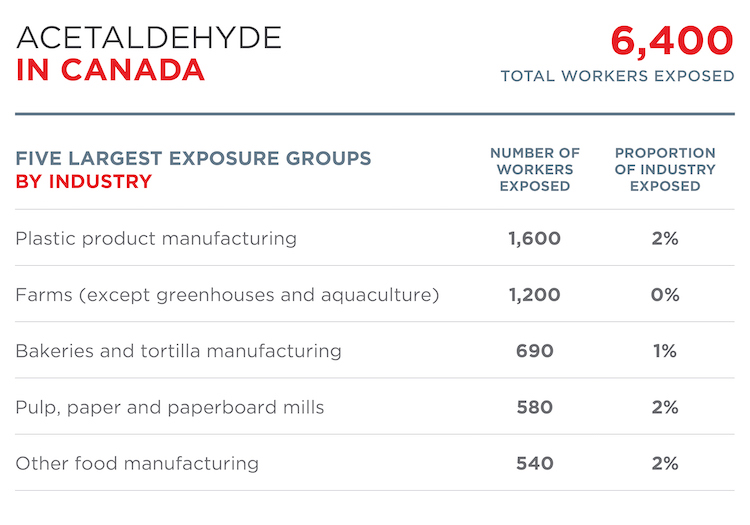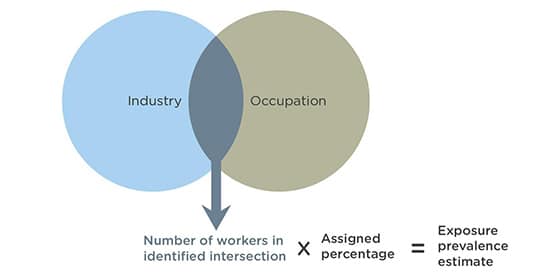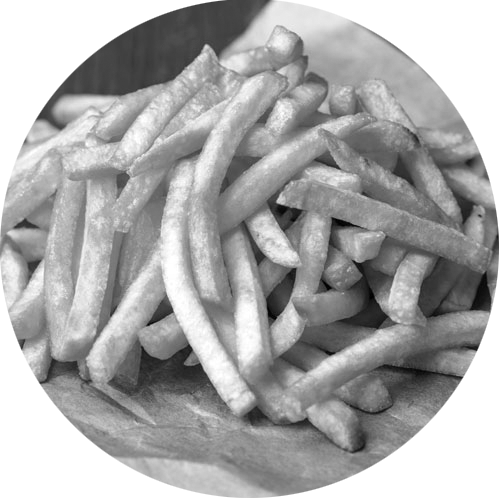Acetaldehyde – Occupational Exposures
Acetaldehyde Occupational Exposures
Acetaldehyde Occupational Exposures
Overview
Inhalation is the most important route of occupational exposure.[1] CAREX Canada estimates that approximately 6,400 Canadians are exposed to acetaldehyde in the workplace.
READ MORE...
The largest industrial groups exposed are plastic products manufacturing, farms, and bakeries and tortilla manufacturing. By occupation, the greatest exposures occur among labourers in food and beverage processing, managers in agriculture, and process control and machine operators in food and beverage processing.
In food manufacturing, workers are exposed to acetaldehyde during diacetyl production. Diacetyl is a substance used for food flavouring, especially in microwave popcorn. Recent studies from the Netherlands[2] and the US[3] have measured acetaldehyde exposure during production of diacetyl.
Because acetaldehyde is also a combustion product, exposure in the petroleum, transportation, waste burning, fire fighting, and wood products industries is also possible.[4]
Prevalence Estimate
Results show that approximately 6,400 Canadians are exposed to acetaldehyde in their workplaces; 69% of these workers are male. The largest industrial groups exposed are plastic products manufacturing, farms, and bakeries and tortilla manufacturing. In the farming industry, acetaldehyde is a major degradation production of a common molluscicide called metaldehyde.
When exposure is examined by occupation, the largest exposed group is labourers in food and beverage processing (1,100 workers exposed), managers in agriculture (720 workers exposed), process control and machine operators in food and beverage processing (720 workers exposed), and plastics processing machine operators (620 workers exposed).
The number of workers exposed to acetaldehyde decreased by approximately 2,200 workers from 2006 to 2016 (a 26% decrease). This was primarily driven by a decrease in the number of workers in the forestry industry.
Workers exposed to acetaldehyde by industry in 2016

Workers exposed to acetaldehyde by region in 2016
Click the second tab to view total number of workers exposed.
* = < 50 workers
Methods and Data
Our Occupational Approach page outlines the general approach used to calculate prevalence and exposure level estimates for workplace exposures.
Data Sources
Data used in developing the occupational estimates for acetaldehyde were collected from several sources:
- The Canadian Workplace Exposure Database (CWED) contains approximately 1,500 measurements for acetaldehyde exposure. These measurements were collected during the years 1981 to 2004 in Ontario and British Columbia workplaces.
- Canadian and US scientific peer reviewed publications that addressed acetaldehyde exposure in Canada and the United States.
- Grey literature including technical reports from governments and international bodies.
Prevalence Estimate Method
CAREX defines exposure to acetaldehyde as inhalation exposure at work to levels above those encountered in the general environment.
To determine the number of workers potentially exposed to acetaldehyde at work, CAREX occupational exposure experts used methods previously established in other peer-reviewed CAREX projects in Europe. A series of steps were taken to assign exposure proportions to occupations and industries at risk of exposure to acetaldehyde.

- Occupations and industries at risk of possible exposure to acetaldehyde were identified using any combination of data sources described above.
- The total number of workers in each identified occupation and industry intersection was obtained from Statistics Canada 2016 census data.
- A percentage of workers exposed was assigned to that occupation and industry intersection. Percentages were determined by consultation with existing evidence in the data sources, previously established methods from the Europe CAREX estimates and the expert judgement of CAREX occupational hygienists.
- The number of workers in the identified group is multiplied by the assigned percentage to calculate the prevalence estimate of workers exposed to acetaldehyde.
Sources
Subscribe to our newsletters
The CAREX Canada team offers two regular newsletters: the biannual e-Bulletin summarizing information on upcoming webinars, new publications, and updates to estimates and tools; and the monthly Carcinogens in the News, a digest of media articles, government reports, and academic literature related to the carcinogens we’ve classified as important for surveillance in Canada. Sign up for one or both of these newsletters below.
CAREX Canada
School of Population and Public Health
University of British Columbia
Vancouver Campus
370A - 2206 East Mall
Vancouver, BC V6T 1Z3
CANADA
As a national organization, our work extends across borders into many Indigenous lands throughout Canada. We gratefully acknowledge that our host institution, the University of British Columbia Point Grey campus, is located on the traditional, ancestral, and unceded territories of the xʷməθkʷəy̓əm (Musqueam) people.







